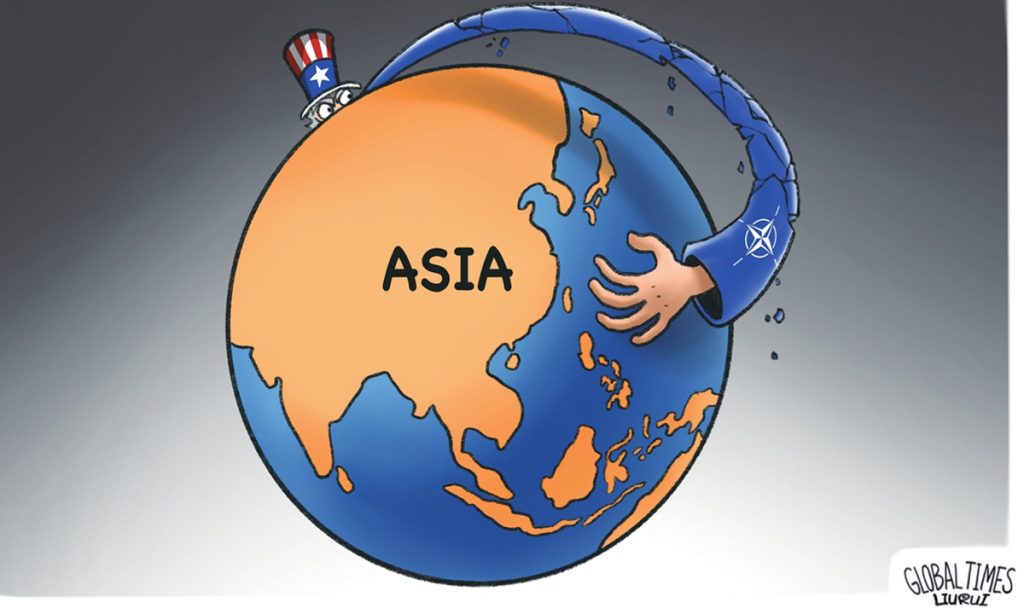Growing US presence in Asia-Pacific is dangerous

A series of bilateral and multilateral meetings were held in Tokyo, including the meeting of US-Japan Security Consultative Committee, known as the "2+2" security talks, the US-Japan-South Korea Trilateral Ministerial Meeting and the Quad Ministerial Meeting that was held from Sunday to Monday. US Secretary of State Antony Blinken and Secretary of Defense Lloyd Austin gathered in Tokyo to accelerate the Asia-Pacific alliance's integration, signaling the Joe Biden administration's continued push for "NATO-ization" of the Asia-Pacific region.
During Blinken's trip to East Asia, his visit to Tokyo might appear to be a brief stop, but it is actually the main focus of the trip. The meetings of Blinken and Austin in Tokyo led to a series of military security cooperation among the US, Japan, South Korea, and other countries, reflecting four major upgrades in the US and Northeast Asia alliance system.
First, the US and Japan are accelerating military integration. Through the "2+2" talks, the US and Japan confirmed that the Japan Self-Defense Forces will establish a "Joint Operations Command," and the US Forces Japan will establish a "joint force headquarters." This will achieve full integration of the US-Japan command and operational system.
Second, the US and Japan held their ministerial-level meeting on the Extended Deterrence Dialogue, where they confirmed that, with Japan's defense support, the US will strengthen cooperation on extended deterrence and escalation management primarily to deter potential nuclear strikes against Japan.
Third, the US, Japan and South Korea seek to "institutionalize" trilateral defense ties. The three countries agreed to strengthen institutionalized cooperation in areas such as information sharing and trilateral exercises, and expressed intent to host their trilateral ministerial meeting on a rotational basis.
Fourth, Japan and South Korea are restarting their defense cooperation. South Korean Defense Minister Shin Won-sik visited Japan on Sunday, marking the first visit by a South Korean defense chief to Japan's defense ministry in 15 years. Prior to this, the two countries made a significant step last month in forging resilient security ties, agreeing to resume defense exchanges.
According to a press release from the US State Department, this was Blinken's "18th trip to the Indo-Pacific region since becoming Secretary." The US claims that it will uphold its "commitment to deepening and expanding ties to unprecedented levels and creating mutually reinforcing relationships to tackle today's greatest challenges." Austin noted in a joint press conference before the trip, "The US has nearly doubled its military construction investments in the Indo-Pacific over the last fiscal year and has continued to make significant improvements to its force posture in the region."
It is clear that the Democratic Party is eager to solidify its "diplomatic legacy" during Biden's remaining time in office. It aims to show the outside world that although it is deeply troubled by the crises in Ukraine and the Middle East, the focus of US foreign policy remains on the Asia-Pacific region. The US' actions are also affected by domestic political factors. The Biden administration hopes to demonstrate "global leadership" of the US.
The US' intensifying plans for great power competition and geopolitical confrontation bring the risk of division and instability for regional countries. At the recently concluded East Asia Summit Foreign Minister's Meeting in Laos, although ASEAN strived to maintain regional unity and cooperation, there were obvious differences in the positions of countries surrounding the Ukraine crisis, the conflict in Gaza, the situation on the Korean Peninsula and the South China Sea affairs.
After Blinken's speech, which emphasized "cooperation" at the ASEAN Post Ministerial Conference on July 27, he quickly shifted to camp confrontation in Tokyo, stirring up geopolitical conflicts and reinforcing military deployments in the Asia-Pacific region. This, without doubt, undermined ASEAN's efforts.
Faced with unprecedented risks of confrontation and division since the Cold War, countries in the Asia-Pacific region need to enhance their crisis awareness and jointly resist the trend of "NATO-ization" of the Asia-Pacific region. Countries in East Asia must adhere to the vision of peace, take into account the demands of all parties, and pursue a path of common, comprehensive, cooperative, and sustainable security.